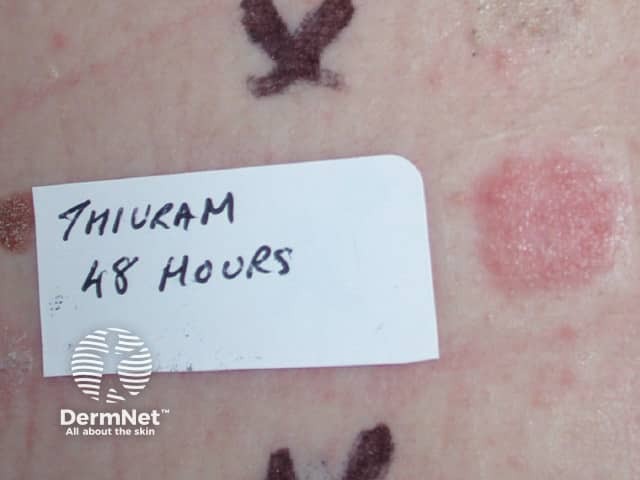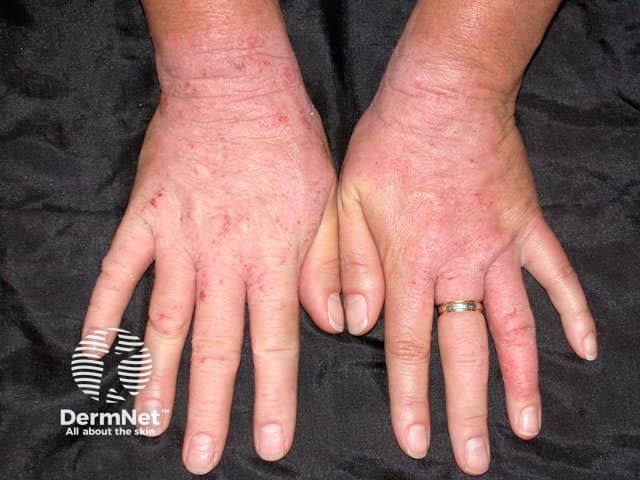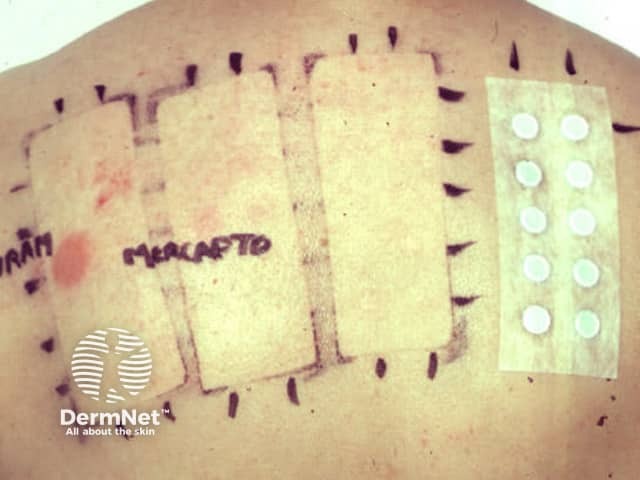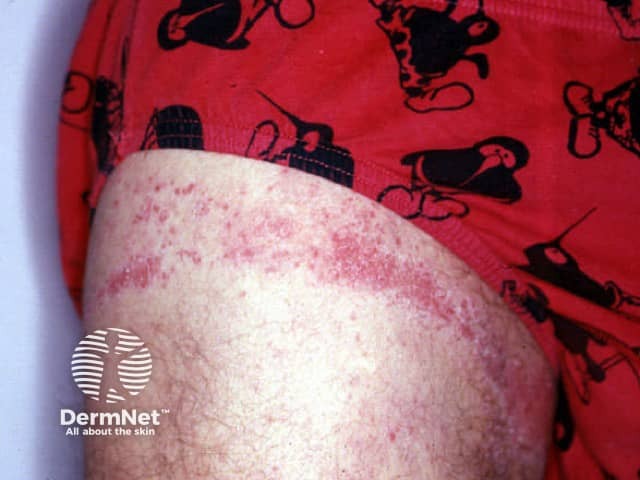Main menu
Common skin conditions

NEWS
Join DermNet PRO
Read more
Quick links
Allergy to rubber accelerators — extra information
Introduction - rubber allergy
Introduction - rubber accelerators
Products with rubber accelerators
Reactions
Demographics
Diagnosis
Prevention
Treatment
Allergy to rubber
Allergic reactions to rubber can be due to allergy to natural latex sap or to one of the many chemicals used in the manufacturing of rubber. The types of chemicals used in the manufacturing of rubber include:
|
|
|
Allergy can probably occur to any of these chemicals, although rubber accelerators seem to cause the greatest problems.
Contact allergy to rubber accelerators

Positive patch test to thiuram

Rubber dermatitis

Patch tests

Rubber dermatitis
What are rubber accelerators?
Rubber accelerators are chemicals used to speed up the manufacturing process of rubber (vulcanisation). This process makes untreated natural rubber latex suitable for use in the manufacture of many rubber products. There are many types of rubber accelerators in use but those listed below cause most cases of rubber contact dermatitis:
Chemical |
Formula |
CAS number |
|
|---|---|---|---|
|
C7H5NS2 C13H16N2S2 C14H8N2S4 C11H12N2S20 |
149-30-4 95-33-0 120-78-5 102-77-2 |
|
|
C10H20N2S4Zn C18H36N2S4Zn C13H13N3 |
14324-55-1 136-23-2 102-06-7 |
|
|
C6H12N2S3 C16H12N2S4 C10H20N2S4 (C5H10NCS3)2 |
97.74.5 137-26-8 97-77-8 120-54-7 |
|
|
(CH2)6N4 |
100-97-0 |
|
What products contain rubber accelerators?
Nearly all rubber compounds contain rubber accelerators. The list below shows the widespread use of rubber products that we may come into contact with daily:
Household/recreational rubber products
- Anti-slip carpet backing
- Balloons
- Elastic bands
- Garden hoses and gloves
- Kitchen gloves
- Pillows and mattresses
- Rubber gloves
- Rubber handled sports equipment, e.g. golf club and raquet tennis racquet handles
- Rubber handles (e.g. bicycles, car steering wheel)
- Rubber kitchen utensils
- Rubber swim caps and goggles
Clothing and footwear
- Elastic in face masks, underwear and swimwear
- Rubber boots
- Sport shoes
- Slippers
- Rubber insoles of shoes
- Elasticised waistbands
- Brassiere cups
Cosmetics and healthcare products
- Rubber make-up sponges
- Diaphragms
- Rubber latex condoms
- Thiuram is in the oral drug Antabuse (used to treat alcoholism)
Work sources
- Commercial and agricultural fungicides and pesticides
- Conveyor belts
- Dental dams
- Earphones
- Elastic bandages
- Electrical cords
- Examination and surgical gloves
- Gas masks
- Lining for fuel tanks
- Protective rubber aprons
- Rubber hoses, seals and cables
- Rubber mats
- Rubber stoppers in medical syringes
- Rubber tires and tubes
- Safety goggles
- Shock absorbers
- Springs
- Stethoscopes
- Veterinary products, e.g. flea and tick sprays/powders
It is often difficult to know which rubber product contains which rubber accelerants. Often the manufacturer of the product will not know either.
What are the reactions to rubber accelerators?
The rash is known as allergic contact dermatitis. It can occur in many areas and in any of several patterns. The following table describes some of the common areas where rubber accelerator allergy may occur, the usual cause, and any distinguishing features of the allergy.
Location |
Cause |
Features |
|---|---|---|
Hands |
|
|
Face |
|
|
Feet/shoe dermatitis |
|
|
Genitals |
|
|
Other parts of the body |
|
|
How did I become allergic to rubber accelerators?
Chronic exposure is a likely reason. Surgeons, nurses, dentists, hairdressers and others who wear rubber gloves for work purposes can often develop sensitivity to natural rubber latex and rubber accelerators. In these cases allergy to rubber may come as a consequence of trying to protect your hands from other allergens.
Am I allergic to rubber accelerators?
Allergy to rubber accelerators is diagnosed by the clinical history and by special allergy tests, patch tests. These tests may identify which specific rubber accelerators you have an allergy to.
Thiuram mix tests four thiuram chemicals with one test. One of these four will cause about 9 out of 10 cases of allergy to thiuram mix. Similarly, mercapto mix tests for 3 chemicals in the one test.
You can self-test a rubber product for allergy, but this should only be done only after first talking with your dermatologist. Do this only with articles that are designed to stay on the skin, such as underwear or shoes. Initially, allow the article to be in contact with your skin of your forearm for a short period of time, say 1 hour. For the next 4 days look for any reaction. If no reaction occurs slowly lengthen the period of contact with your skin to a maximum of 48 hours.
Do not test insecticides or other chemical products in this way.
What should I do to avoid rubber accelerator allergy?
The best way to avoid rubber accelerator allergy is by being aware of products that contain rubber accelerators. However, it is generally difficult to determine which products contain rubber accelerators and which don't.
Minimize your exposure to all rubber products. Use alternative products made of vinyl, plastic, wood, leather or fabric. Even though some rubber gloves are labelled 'hypoallergenic' it is wise to contact the manufacturer to determine if they contain any of the rubber accelerators you are allergic to. Vinyl gloves may be a suitable alternative although some people are allergic to both rubber and vinyl. Tactylon® gloves are a good alternative for most people. Be aware that some non-rubber gloves provide less protection against viruses and certain chemicals than rubber gloves. Discuss the requirements of your gloves with your supplier/manufacturer.
If you are sensitive to rubber accelerators and undergoing dental work or surgery, you should inform your dentist or doctor so they can either use alternative gloves that are free of rubber accelerators, or patch test you in advance with the gloves they plan to use.
Avoid shoes made with rubber accelerators. Test shoes by wearing them for a few days and watch for a rash (shoe dermatitis) or have shoes patch tested. Any socks or stockings that have been worn with shoes that cause an allergy may become contaminated with rubber. These should not be worn again, as even washing may not remove the contaminant.
Non-rubber condoms (e.g. Durex Avanti) and plastic diaphragms may be suitable contraceptive alternatives. Cover padded arms of upholstered furniture with a towel and avoid walking barefoot on rubber-underlayed carpets.
Tricks to minimise contact with earloops of face masks include using paperclips or hospital wristbands to hold the earloops behind the head.
Treatment of rubber accelerator allergy
Treatment of the rash caused by rubber accelerators is with medications that are used to treat acute dermatitis/eczema.
Shoe dermatitis needs to be properly diagnosed and treated. Contact dermatitis of the feet can often become infected with Staphylococcus aureus (it can also be confused with the fungal infection, tinea pedis). Acute dermatitis can be treated with wet dressings of Burrow's solution or dilute vinegar. Short courses of systemic corticosteroids may speed up healing. Chronic shoe dermatitis may need to be managed with prolonged treatment of topical corticosteroids and/or coal tar and emollients. It is essential that you wear shoes free of the causative allergens.
References
- Book: Fisher's Contact Dermatitis. Ed Rietschel RL, Fowler JF. Lippincott Williams & Wilkins 2001
- Bothra A, Das S, Singh M, Pawar M, Maheswari A. Retroauricular dermatitis with vehement use of ear loop face masks during COVID-19 pandemic. J Eur Acad Dermatol Venereol. 2020;34(10):e549-52. doi:10.1111/jdv.16692 Journal
On DermNet
- Hand care in healthcare workers
- Dermatitis
- Allergic contact dermatitis
- Gloves for hand protection
- Patch testing
- Natural latex allergy
- Skin reactions to face masks
- Surgical gloves
- Shoe dermatitis
- Occupational skin disorders in homemakers
